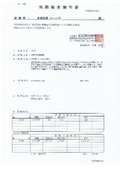Photocatalyst "Titanistar": Performance of Liquid Phase Reaction System
Fading of colored components in livestock wastewater and antibacterial performance! Introduction to tests conducted at the Kyoto Prefectural Livestock Research Institute.
We will introduce the performance of the liquid-phase reaction system of the photocatalyst "Titanistar." ■ Decolorization of colored components in livestock wastewater - Testing Institution: Kyoto Prefectural Livestock Research Institute We conducted tests to decompose the colored water components treated by the activated sludge method provided by the Kyoto Prefectural Livestock Center using Titanistar. We selected pure titanium mesh material and applied treatment with the MI-C type of Titanistar's liquid-phase reaction system to create test samples. The ultraviolet intensity was set at BLB 1mW/cm², and the degree of decolorization of the colored water was measured using a color difference meter. The results showed that as the irradiation time increased, the colored components gradually decomposed and became lighter. *For more details, please download the PDF or feel free to contact us.
basic information
What is the photocatalyst "Titanistar"? It is not a coating-type photocatalyst, nor does it use any of the raw materials employed in those types. By simply performing surface oxidation treatment on titanium within pure titanium metal, a titanium dioxide photocatalytic film is generated on the surface of pure titanium. This film contains no impurities and is generated without any interface with pure titanium. It is characterized by high photocatalytic ability and a highly durable film. ■ Antibacterial Performance Testing Institution: Kyoto Microbial Research Institute Antibacterial performance tests were conducted against Escherichia coli, Staphylococcus aureus, and Bacillus subtilis. Titanium plates treated with MI-W from the gas-phase reaction system and MI-C from the liquid-phase reaction system of the Titanistar series were prepared as test samples, while untreated titanium plates served as blanks. After a preliminary irradiation of BLB 1mW/cm2, tests were conducted using the film adhesion method. As a result, it was confirmed that the viable bacterial counts for various Titanistar types exhibited remarkably high antibacterial performance. *For more details, please download the PDF or feel free to contact us.
Price range
Delivery Time
Applications/Examples of results
For more details, please download the PDF or feel free to contact us.
catalog(11)
Download All Catalogs



Recommended products
Distributors
Yield Co., Ltd. manufactures and sells chemical industrial products. Our main products include titanium dioxide photocatalytic materials "Titanistar" and high-performance water purification devices "Aquabeam." Please feel free to contact us if you have any inquiries.

































